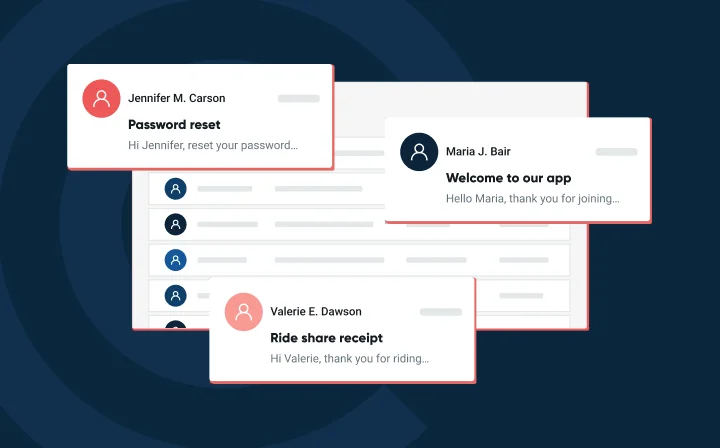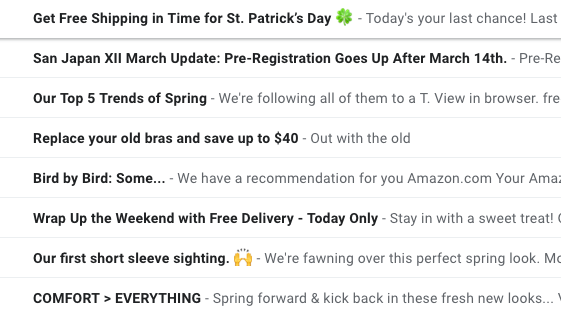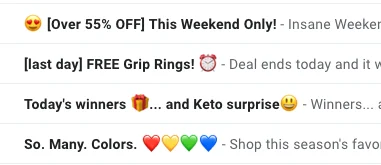Emoji in email and email subject lines: Should you use it?


Emojis are showing up everywhere; seriously, they’ve got their own holiday to show for it (World emoji day; yes, it’s a thing.) They’re bright, attention-grabbing, and in places where space is limited like a mobile device — they save a ton of room. Naturally, this raises the question of whether or not they make sense to use in your email marketing or digital marketing as a whole.
But before you go crazy putting emojis in your email campaigns and email subject lines, there are a few things to consider.
There are a few ways to utilize emojis in your subject lines. The number one way is to have a pop of color that differentiates your email from the other emails in the recipient’s inbox. They can be visually striking and more fun than an email that is composed of only words. Using emojis as replacements for words is another common use of them, and one that saves your space as well.
So, if you’re an email marketer trying to alert people on your email list to a new t-shirt sale, you could phrase it a few ways. “20% off new T-Shirt Designs” is less fun, colorful, and emphatic than “Get 20% off these 🔥 new shirts!” Or, you could say something like “Get 20% off new 👕 now!!” for a similar effect. Anything that stands out against text like this:

That brings me to my next point — don’t go overboard. Overuse of emojis in your email subject lines or in the body of your email can look like you’re trying too hard or worse, like a spammer. I’d avoid a subject like “🙌😱2️⃣0️⃣% off 🔥 new 👕👚 now‼️✨” Because chances are, ISPs like Google’s Gmail are going to send you straight to the spam folder.
Think about how you and your friends use emojis in text conversations, and how you see others use them. Emojis should feel natural and add a bit of flair and excitement to your text. You don’t want to flood people’s inboxes with emojis just because millennials like, totally use a ton of smiley face emojis — right?
A key factor in deciding what emojis to use, and whether or not to use them at all, is who is receiving your email messages. If you have a younger demographic and are selling a fun, light-hearted product, then the use of emojis is warranted. However, if you have an audience comprised mostly of older people and professionals, or if you’re selling a B2B oriented service, emojis in your subject lines may not land as well.
The line between people who will like emojis showing up in their emails and those who won’t isn’t always clear cut, and there are a few risks/rewards to be aware of before deciding whether or not to use them:
Since emojis aren’t a concrete way of communicating and are better used to convey emotions, not everyone is going to read your emoji the same way. Just like how we can misread people’s facial expressions and body language, we can misinterpret the intent of an emoji. This opens up the possibility of someone reading your email subject line in a way that either doesn’t make sense or directly opposes the intent of what you wrote.
Another thing to be aware of is that because some emojis aren’t standardized the way letters and numbers are, different apps, operating systems, and services will use different emoji graphics. While many emojis are in unicode, and will translate across different devices, not all of them are. You can always check what they will look like on various devices with websites like Emojipedia, but you still run the risk of not having enough emoji support. Plus, the emoji you’re using could not exist on other keyboards yet, and your recipient will only receive an ◻︎ in its place.
Nothing quite conveys “Hey open me! I’m fun and interesting,” like “◻︎◻︎ New◻︎ Products out◻︎◻︎◻︎◻︎.” Unfortunately, this is an issue that isn’t entirely in your control because different email clients are going to use one of a few different emoji keyboards based on the device’s operating system. For example, if the Samsung Android keyboard is missing a brand-new emoji set that is on the Apple iOS keyboard, everyone reading your subject line on an Android device won’t see it.
The biggest risk of all when you’re sending emojis out in emails is that misusing or using too many of them can just look stupid, make you seem out of touch, and like you don’t know how to communicate with the young people. Really resist any temptation to use a heavy hand when crafting your subject lines, a little goes a long way here. Otherwise, you can end up in the spam folder with subject lines like this:

I said it earlier, but I’ll reiterate here— emojis and emoticons are great at grabbing people’s attention. If you open your email and only one subject line has an emoji in it, that’s probably the first place your eye is going. The bright pop of color, especially against the new dark modes available on some devices, draws people in.
Correctly using emojis in a genuine and engaging way can make your emails more personable, and make people feel like they’re connecting with a real person on the other side of that email. That’s a powerful thing in an age where people are bombarded with messaging in emails, texts, online ads, and on social media.
Flaws and rewards aside, what role does emoji use play in your email sending and overall deliverability? As surprising as it might sound, it can help improve your chances of landing in the inbox when used appropriately.
Yes, ISPs like Gmail don’t completely hate emojis, it all depends on how you’re using them. Again, this all falls back to who you are writing to in the first place, your audience.
Emojis can be stupid, fun, and even funny when you use them correctly. If you slap a sea of emojis in your subject line like some sort of pictorial language, chances are nobody is going to open your email. Sure, you land in the inbox, but your engagements will take a hit.
Remember to think about them as a nice accent piece to whatever your subject line is overall. The emoji itself isn’t the subject but instead spotlights the subject to draw attention to it. That emphasis is what encourages engagements; better engagements help your reputation and ultimately — your deliverability.
If you’re trying to increase open rates, connect with your audience in a more casual way, or just generally step up your email game, emojis are a great tool you can keep in your toolkit, just remember to use a light touch.
What it comes down to is who you are targeting with your email marketing, why they are receiving it, and what effect you want the emoji to have on them. Emojis deliver a delightful pop of color to liven up people’s inboxes, but I’d caution you to make sure you aren’t going overboard and making your email blasts look like spam.

Earlier in 2019, we cohosted a webinar with Iterable! Nick, our Deliverability Engineer, and Iterable’s panel of experts took a critical look at different email best practices and what’s real, what isn’t, and something that’s up for debate in the email marketing space. You can find the webinar here.